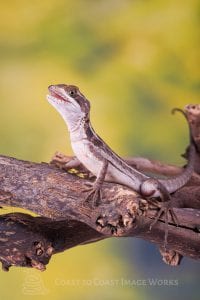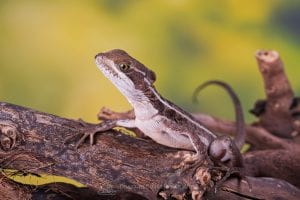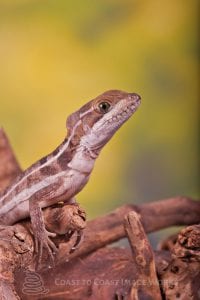 Brown Basilisks are an overlooked species of Iguanid lizard, generally the flashier Plumed Basilisk with its bright green colouration and bigger crests take the attention of most potential keepers. That’s a shame, as given the chance the Brown Basilisk is a great vivarium subject and has the added bonus of being smaller than the Plumed. In the wild they occur in the tropical and sub-tropical regions of Mexico, Central America and into Columbia and are relatively commonly found. They share the well-known ability to run over water on their hindlegs, their rear feet have developed skin between their toes that aids this – along with the superfast speed they can achieve. Along with the Plumed Basilisk they are not a commonly kept species in captivity, the large vivarium they will require
Brown Basilisks are an overlooked species of Iguanid lizard, generally the flashier Plumed Basilisk with its bright green colouration and bigger crests take the attention of most potential keepers. That’s a shame, as given the chance the Brown Basilisk is a great vivarium subject and has the added bonus of being smaller than the Plumed. In the wild they occur in the tropical and sub-tropical regions of Mexico, Central America and into Columbia and are relatively commonly found. They share the well-known ability to run over water on their hindlegs, their rear feet have developed skin between their toes that aids this – along with the superfast speed they can achieve. Along with the Plumed Basilisk they are not a commonly kept species in captivity, the large vivarium they will require  undoubtedly plays a part in this.
undoubtedly plays a part in this.
Aim for an absolute minimum of six feet long, three feet tall vivarium for one, maybe a pair at a push, with more space being recommended. The vivarium will need to be constructed of a material which will take a higher level of dampness, spraying, splashing and overall humidity – a glass or similar vivarium is most suitable. Other vivaria will almost certainly not last very long, maybe two years maximum. Furnish the vivarium with a substrate that maintains high levels of humidity, we have had good success with orchid bark, coir and of substrates sold for plants. Some keepers have used stout, sturdy real living plants, and the results are certainly a more natural looking vivaria – but it can be tricky. This medium sized lizard can damage plants easily as they move around, but the end result can be a fantastic looking vivarium. A relatively large area of water, deep enough to submerge is required, preferable with overhanging branches so the Basilisks can drop into the water when startled – natural behaviour.
 Heating and lighting for many lizard species has become a hotly debated topic in recent years. The specific heaters and lights are often best left to the choice of the keeper. Needless to say this species is a basking diurnal species, meaning it basks in direct sunlight to heat up so it is active during the day – night time activity is limited. For this reason, a heater and all light sources need to be fastened to the ceiling of the vivarium, pointing at the lizard. Ceramic heaters, halogen lights and incandescent bulbs have all been successfully used, with each “camp within the hobby” arguing which works best. My personal choice would be the use of a ceramic heater, backed by supplementary T5 lighting, perhaps with extra halogens if it was a
Heating and lighting for many lizard species has become a hotly debated topic in recent years. The specific heaters and lights are often best left to the choice of the keeper. Needless to say this species is a basking diurnal species, meaning it basks in direct sunlight to heat up so it is active during the day – night time activity is limited. For this reason, a heater and all light sources need to be fastened to the ceiling of the vivarium, pointing at the lizard. Ceramic heaters, halogen lights and incandescent bulbs have all been successfully used, with each “camp within the hobby” arguing which works best. My personal choice would be the use of a ceramic heater, backed by supplementary T5 lighting, perhaps with extra halogens if it was a  large vivarium. As the ceramic heater does not give off visible light it’s suitable for night-time also. Daytime temperatures need to be around 32-34C under the basking areas, access to cooler areas, and dropping the ambient temperature to around 24-28C at night (this may be altered seasonally, especially if breeding is attempted). It is essential to provide UVB lighting, I highly recommend the use of the newer T5 lighting tubes rather than T8’s – this one tube gives off a full spectrum, much brighter light with better levels of UVB output over longer time periods.
large vivarium. As the ceramic heater does not give off visible light it’s suitable for night-time also. Daytime temperatures need to be around 32-34C under the basking areas, access to cooler areas, and dropping the ambient temperature to around 24-28C at night (this may be altered seasonally, especially if breeding is attempted). It is essential to provide UVB lighting, I highly recommend the use of the newer T5 lighting tubes rather than T8’s – this one tube gives off a full spectrum, much brighter light with better levels of UVB output over longer time periods.
This species tends to be a greedy feeder once settled into its vivarium and surroundings – they can be nervous at first. They generally feed greedily on all commercially available livefood insects such as locusts, crickets, cockroaches, waxworms and worms. Always feed the livefood to “gutload” it, whatever is inside the insect passes to the Basilisk – a more balanced diet can be achieved. However this does not mean a vitamin and mineral supplement should not be used – always use a good quality powder that is balanced for the species you are keeping.
